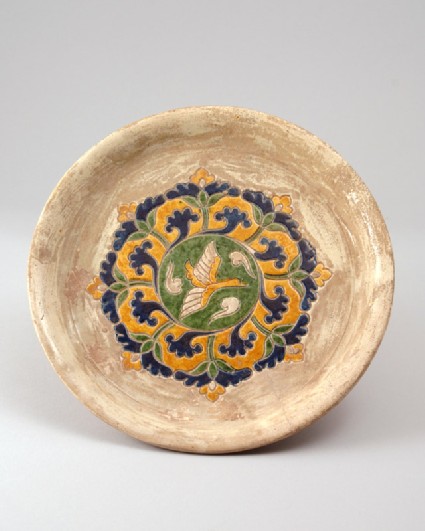The Barlow Collection
A select catalogue of the Barlow collection of Chinese Ceramics, Bronzes and Jades by the University of Sussex (published Sussex, 2006).

Publications online: 456 objects
Show search helpTripod dish with wild goose in flight
- loan
-
Literature notes
The dish has low rounded sides with a flared rim and three bulging stylized animal legs resting on ‘paws’. The inside is impressed with a large rosette with a central roundel containing a wild goose in flight among three cloud motifs, surrounded by spiralling lotus flowers and cloud motifs. The design is covered in green, yellow, cobalt-blue and transparent glazes, the rest of the dish has a transparent glaze, which is largely degraded through burial, and the underside was left in the biscuit. -
Details
- Associated place
-
Asia › China › Henan province (Gongxian kiln-sites) (place of creation)
- Date
-
8th century AD (AD 701 - 800)
Tang Dynasty (AD 618 - 907)
- Material and technique
- earthenware, thrown, with impressed decoration under green, yellow, and cobalt-blue transparent glazes; feet hand-modelled and luted to the dish with slip; unglazed base; glazed rim
- Dimensions
-
6.8 cm (height)
28.8 cm (diameter)
- Material index
- Technique index
-
- Object type index
- No. of items
- 1
- Credit line
- Lent by the Sir Alan Barlow Collection Trust.
- Accession no.
- LI1301.131
-
Further reading
University of Sussex, and Arts and Humanities Research Council, The Barlow Collection, supervised by Regina Krahl, Maurice Howard, and Aiden Leeves (Sussex: University of Sussex, 2006), no. C106
Glossary (3)
earthenware, luted, slip
-
earthenware
Ceramic material made of clay which is fired to a temperature of c.1000-1200⁰c. The resulting ceramic is non-vitreous and varies in colour from dark red to yellow.
-
luted
The fusion of parts of ceramics using dilute clay slip.
-
slip
A semi-fluid clay applied to a ceramic before glazing either to coat the surface or for decorative effect.
Location
-
- currently in research collection
Objects are sometimes moved to a different location. Our object location data is usually updated on a monthly basis. Contact the Jameel Study Centre if you are planning to visit the museum to see a particular object on display, or would like to arrange an appointment to see an object in our reserve collections.
Publications online
-

The Barlow Collection
The dish has low rounded sides with a flared rim and three bulging stylized animal legs resting on ‘paws’. The inside is impressed with a large rosette with a central roundel containing a wild goose in flight among three cloud motifs, surrounded by spiralling lotus flowers and cloud motifs. The design is covered in green, yellow, cobalt-blue and transparent glazes, the rest of the dish has a transparent glaze, which is largely degraded through burial, and the underside was left in the biscuit.
Notice
Object information may not accurately reflect the actual contents of the original publication, since our online objects contain current information held in our collections database. Click on 'buy this publication' to purchase printed versions of our online publications, where available, or contact the Jameel Study Centre to arrange access to books on our collections that are now out of print.
© 2013 University of Oxford - Ashmolean Museum


